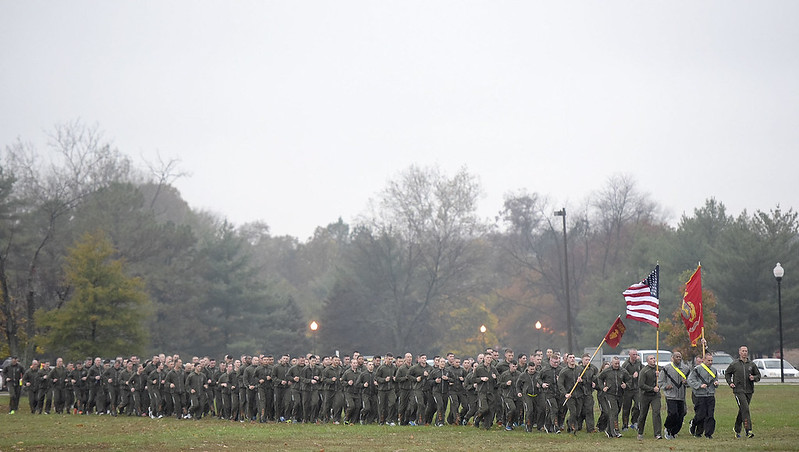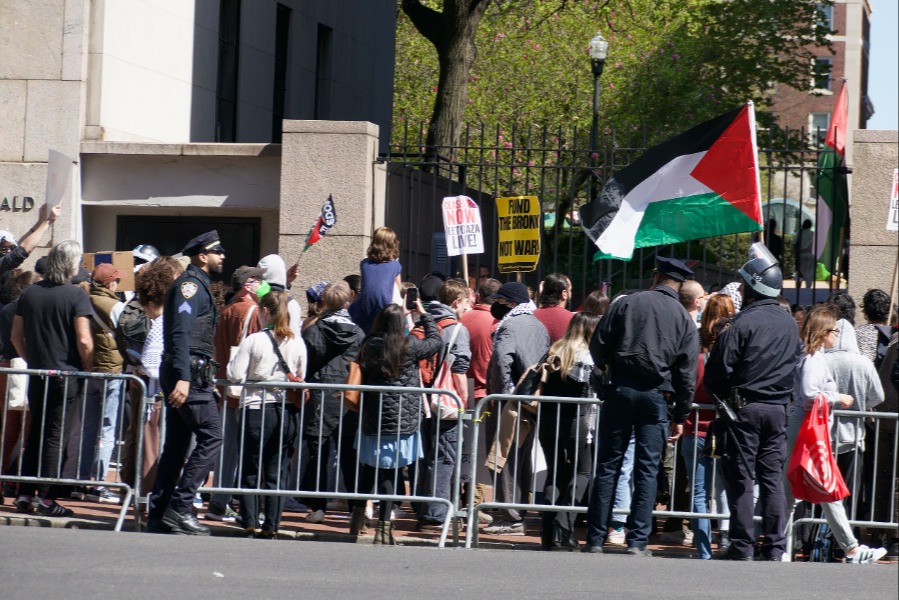Getting to Ground Truth on the Reach of Domestic Violent Extremist Groups Into the Military, Veteran, and Law Enforcement Communities

Published by The Lawfare Institute
in Cooperation With

On Jan. 17, three active-duty Marines, Cpl. Micah Coomer, Sgt. Joshua Abate, and Sgt. Dodge Dale Hellonen, were each charged with four misdemeanors in connection with the Jan. 6 attack on the U.S. Capitol. Among the charges were allegations of disorderly conduct and trespassing in the Capitol building. Unlike many of the more than 100 veterans who were charged in Jan. 6-related offenses, these Marines were still serving on active duty and held senior-level intelligence positions: one as an intelligence surveillance reconnaissance system engineer and two as special communications signals intelligence analysts.
While the Marines were charged for relatively minor nonviolent offenses, FBI affidavits nonetheless indicate troubling findings. Cpl. Coomer shared on social media that, when he was at the Capitol on Jan. 6, he was “glad to be apart [sic] of history.” Further, in private messages to others, he used phrases such as “everything in this country is corrupt” and wrote that he was “waiting for the boogaloo” (which he later clarified to mean “Civil War 2”). Court documents further reveal that Sgt. Abate was stationed in Fort Meade, Maryland, supporting the National Security Agency’s Marine Cryptologic Support Battalion, and disclosed his participation in entering the Capitol building during his most recent security clearance interviews. While the Marine Corps stated that it is cooperating fully with the Department of Justice’s investigation, it remains unclear whether the three will face additional military justice charges.
So what to make of these charges against three Marines—individuals who, in their professional capacities, adhere to an oath to the Constitution and ethical expectations of the Corps, but privately expressed sentiments aligned with the insurrectionists, and are alleged to have engaged in criminal activities that run counter to that same oath? And what about others charged in connection with the Jan. 6 attack on the Capitol who have ties to military and/or law enforcement, which, as of January 2023, represents approximately 140 out of the more than 970 cases?
Engagement by military personnel, law enforcement officers, or veterans in domestic violent extremism (DVE) is not a new phenomenon. Our recent report, “Protecting the Protectors: Preventing and Mitigating Domestic Violent Extremism in the Military, Veteran and Law Enforcement Communities” (along with co-author Josh Campbell), detailed how DVE groups—such as the Proud Boys, Oath Keepers, Three Percenters, and the “boogaloo” movement—target members of these professional communities. Moreover, as extremism and radicalization expert Cynthia Miller-Idriss highlighted in her October 2021 testimony before the House Committee on Veterans’ Affairs, “Veterans are demonstrably more vulnerable to recruitment and engagement in the extremist fringe, compared to the civilian population …. Nearly a third of far-right terrorists in the American Terrorism Study Database between 1980-2002 had military experience[.]” One of the most notable cases in American history, the Oklahoma City bombing, was perpetrated by Timothy McVeigh, an Army veteran; the attack remains the deadliest incident of domestic terrorism in U.S. history.
But what drives some members and veterans of the military and law enforcement communities to become involved with DVE groups? In militia expert Amy Cooter’s written statement for the record to the House Committee on Veterans’ Affairs for the October 2021 hearing, she wrote that militia members told her “that they wanted to join something like a militia to stand up to the tyranny they perceived as coming from the federal government.” Cooter also explained that “[t]hey believed they were joining patriotic organizations to fight extremism and tyranny that was originating from government actors who were ungrateful for their service.” Given these assessments, an outstanding policy question is whether—and, if so, to what extent—the executive branch has responsibilities to understand, and proactively address, the reach of DVE groups into the military, veteran, and law enforcement communities.
National security policymakers generally agree that DVE poses a significant threat within the United States. Last year, congressional testimonies by Secretary of Homeland Security Alejandro Mayorkas, FBI Director Christopher Wray, and National Counterterrorism Center Director Christine Abizaid all pointed to the substantial threat posed by DVE groups.
In response to the threats posed by DVE, the executive branch implemented several initiatives and updates to policy. The first major effort arrived in February 2021, when Secretary of Defense Lloyd Austin ordered a department-wide stand-down to address extremism within the ranks. The order called for commanding officers and supervisors to spend one day within a 60-day time frame to relax operational standards and lead discussions regarding the “importance of [their] oath of office; a description of impermissible behavior; and procedures for reporting suspected, or actual, extremist behaviors in accordance with the [Department of Defense Instruction].” Secretary Austin further established a Countering Extremism Activity Working Group (CEAWG) to form long-term recommendations for countering DVE in the department. The Defense Department released the CEAWG’s recommendations and updated Department of Defense Instruction in December 2021.
In June 2021, the Biden administration released the first-ever National Strategy for Countering Domestic Terrorism. The strategy assesses that current domestic terrorism and DVE are driven by “a range of violent ideological motivations, including racial or ethnic bigotry and hatred as well as anti–government or anti–authority sentiment.” The strategy assigns responsibility and authority to the Department of Homeland Security to expand its “efforts to provide financial, educational, and technical assistance to those well placed to recognize and address possible domestic terrorism recruitment and mobilization to violence[.]” It further dictates that the Justice Department and the FBI have the responsibility to be lead authorities in investigating and prosecuting domestic terrorism and domestic violent extremist cases.
Federal law enforcement departments and agencies have since updated some of their practices and policies in line with the strategy’s guidance. For example, the Department of Homeland Security designated domestic violent extremism as a National Priority Area within the department’s grant program, and the National Security Division of the Justice Department stood up a new domestic terrorism coordination unit. The FBI has surged both its workforce and the number of investigations devoted to domestic terrorism.
In an effort to take stock of these various policy initiatives, the Center for a New American Security launched a project examining DVE in the military, veteran, and law enforcement communities in February 2022. The goal of the project, a collaborative partnership between our Military, Veterans and Society Program and our Securing U.S. Democracy Initiative, was to assess current federal policies intended to screen for, identify, and prevent DVE within the ranks. Additionally, we sought to extrapolate best practices that disparate law enforcement entities at the federal, state, and local levels could adopt.
We found that there is a significant lack of data, hampering policymakers’ ability to even understand how deeply rooted the problem may be. There is limited information regarding the reach of DVE groups within the military and law enforcement communities—or even data indicating whether personnel within organizations would know how to handle the presence of DVE if they were to observe it. To close this data gap, we sent out a survey to hundreds of law enforcement officers through trusted leaders in the community in an effort to ascertain the extent to which they felt prepared to address DVE within their departments. Responses were negligible. After receiving minimal responses, we redistributed the survey to a broader network. Again, responses remained in the single digits.
It’s possible that cybersecurity training prevented higher engagement with the survey to some degree, but we believe that this lack of responsiveness is revealing of a broader issue of insularity: The poor response rate was due—at least in part—to cultural norms within the law enforcement community intended to protect members from engaging with outsiders, particularly with respect to sensitive issues. The law enforcement professionals engaged on our task force supported this assessment.
Related to the data gap is the cultural stigma surrounding efforts to even talk about the influence of DVE organizations within the military, veteran, and law enforcement communities. Publicly, national security and law enforcement leaders are relatively quiet about the issue. Privately, numerous military and law enforcement officials—current and former—told us that there is indeed a problem, and that most organizations, particularly in the diffuse law enforcement community, do not know how to address it.
Moreover, over the course of the research year, we observed a significant shift in the political ground regarding congressional attitudes about the prevalence and problem of DVE within the military and law enforcement communities. In July 2022, members of the Senate Armed Services Committee (SASC) issued a report directing an immediate halt to countering violent extremist (CVE) efforts within the Defense Department. The reporting language was based on the CEAWG findings that one in every 21,000 service members (or approximately 0.005 percent) committed acts of prohibited violent extremism, a number deemed statistically insignificant by a majority of SASC members. The SASC report further highlighted the resources currently invested in CVE—nearly 5,359,000 hours and $500,000, as the chairman of the Joint Chiefs of Staff reported to the SASC on Jan. 2, 2022. The committee stated that “the case incident rate does not warrant a Department-wide effort on the issue” and that spending extra time and resources to address DVE in the military is an “inappropriate use of taxpayer funds and should be discontinued by the Department of Defense immediately.” To some members of the SASC, the “narrative surrounding systemic extremism in the military besmirches the men and women in uniform,” indicating that policies intended to counter DVE in the military do not have Senate support.
The House Armed Services Committee’s proposed legislation in the National Defense Authorization Act (NDAA) included several provisions that would have addressed domestic extremism but did not make it into the final NDAA. Of these deleted provisions, one notable legislative provision was a call for the “implementation of certain recommendations regarding screening individuals who seek to enlist in the Armed Forces and countering extremist activity in the Department of Defense.” The only House provision that was adopted in the final NDAA was a call to screen social media usage for connections to extremist ties; however, the provision was limited to reporting on social media usage by foreign terrorist organizations in the final text, excluding screening for domestic terrorist organizations. The provision requires the director of national intelligence to report on “the threat posed to the national security of the United States by the online radicalization of terrorists and violent extremists with ties to foreign governments or elements thereof, foreign organizations, or foreign persons, or international terrorist activities.”
Ongoing debates within congressional committees complicate the executive branch’s ability to spend time and money to counter DVE within these specific professional communities. However, congressional challenges to CVE efforts are not the only limitation to progress. For its part, the Department of Homeland Security did not publish findings from any follow-up review that may have been conducted after its March 2021 preliminary review by its chief security officer. And the Justice Department has made no visible signs of conducting an internal review of whether DVE within the ranks of its law enforcement personnel is an issue of departmental leadership concern.
Our research indicates that there are steps that the Defense Department and law enforcement agencies can take independently. Both the military and law enforcement communities can enact more stringent social media screening of applicants during the recruitment phase. Law enforcement agencies should apply the same recruitment standards to the recruitment of veterans that they do to civilians. Transitioning service members and law enforcement officers should be educated about DVE recruitment trends, specifically in order to gain awareness that they may be targets of recruitment by DVE organizations. They should further be connected with resources and networks intended to reintegrate them into their communities when their tour in public service ends.
Top-down initiatives are undoubtedly important for countering DVE within the military, veteran, and law enforcement communities. But perhaps the most critical of our findings is the need for existing professional ethics to be reinforced by their members. Existing professional military education and law enforcement in-service training should provide opportunities to remind those who are currently serving of the oath they took to defend the Constitution and the nation.






